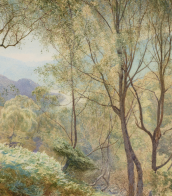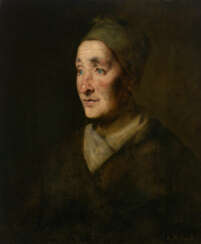огюстен теодюль рибо (1823 - 1891)

Augustin Théodule Ribot was a French realist painter and printmaker.
Ribot painted domestic genre works, still-lifes, portraits, as well as religious scenes, such as his Salon success St. Sebastian, Martyr (1865). The earlier work was drier and austere but still with an intensity of conception and presentation; later works were freer and broader. His preference was for painting directly from nature, emphasizing the contrasts of light and dark. His use of chiaroscuro to suggest psychological states grew from his admiration for Spanish and Dutch baroque masters such as Ribera and Rembrandt, an enthusiasm shared by his contemporaries Courbet and Bonvin. Members of Ribot's family are the likely models for many of his figure compositions, in which the subjects engage in humble activities, such as preparing meals or gathering in groups to read to each other. The light draws attention to faces and hands, which emerge sharply from dimly lit surroundings.


Augustin Théodule Ribot was a French realist painter and printmaker.
Ribot painted domestic genre works, still-lifes, portraits, as well as religious scenes, such as his Salon success St. Sebastian, Martyr (1865). The earlier work was drier and austere but still with an intensity of conception and presentation; later works were freer and broader. His preference was for painting directly from nature, emphasizing the contrasts of light and dark. His use of chiaroscuro to suggest psychological states grew from his admiration for Spanish and Dutch baroque masters such as Ribera and Rembrandt, an enthusiasm shared by his contemporaries Courbet and Bonvin. Members of Ribot's family are the likely models for many of his figure compositions, in which the subjects engage in humble activities, such as preparing meals or gathering in groups to read to each other. The light draws attention to faces and hands, which emerge sharply from dimly lit surroundings.


Augustin Théodule Ribot was a French realist painter and printmaker.
Ribot painted domestic genre works, still-lifes, portraits, as well as religious scenes, such as his Salon success St. Sebastian, Martyr (1865). The earlier work was drier and austere but still with an intensity of conception and presentation; later works were freer and broader. His preference was for painting directly from nature, emphasizing the contrasts of light and dark. His use of chiaroscuro to suggest psychological states grew from his admiration for Spanish and Dutch baroque masters such as Ribera and Rembrandt, an enthusiasm shared by his contemporaries Courbet and Bonvin. Members of Ribot's family are the likely models for many of his figure compositions, in which the subjects engage in humble activities, such as preparing meals or gathering in groups to read to each other. The light draws attention to faces and hands, which emerge sharply from dimly lit surroundings.


Augustin Théodule Ribot was a French realist painter and printmaker.
Ribot painted domestic genre works, still-lifes, portraits, as well as religious scenes, such as his Salon success St. Sebastian, Martyr (1865). The earlier work was drier and austere but still with an intensity of conception and presentation; later works were freer and broader. His preference was for painting directly from nature, emphasizing the contrasts of light and dark. His use of chiaroscuro to suggest psychological states grew from his admiration for Spanish and Dutch baroque masters such as Ribera and Rembrandt, an enthusiasm shared by his contemporaries Courbet and Bonvin. Members of Ribot's family are the likely models for many of his figure compositions, in which the subjects engage in humble activities, such as preparing meals or gathering in groups to read to each other. The light draws attention to faces and hands, which emerge sharply from dimly lit surroundings.


Augustin Théodule Ribot was a French realist painter and printmaker.
Ribot painted domestic genre works, still-lifes, portraits, as well as religious scenes, such as his Salon success St. Sebastian, Martyr (1865). The earlier work was drier and austere but still with an intensity of conception and presentation; later works were freer and broader. His preference was for painting directly from nature, emphasizing the contrasts of light and dark. His use of chiaroscuro to suggest psychological states grew from his admiration for Spanish and Dutch baroque masters such as Ribera and Rembrandt, an enthusiasm shared by his contemporaries Courbet and Bonvin. Members of Ribot's family are the likely models for many of his figure compositions, in which the subjects engage in humble activities, such as preparing meals or gathering in groups to read to each other. The light draws attention to faces and hands, which emerge sharply from dimly lit surroundings.










